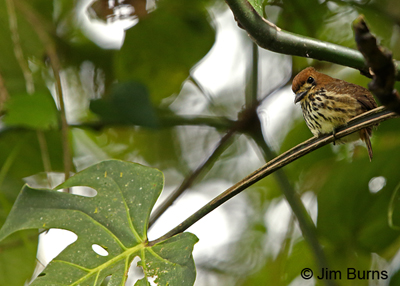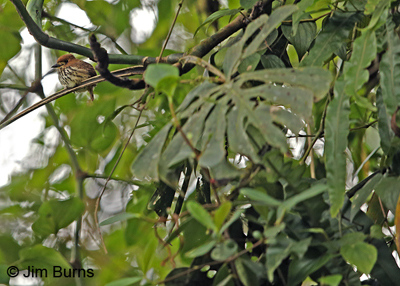
As foreign traveling birders will appreciate, the first few trips were spent, heads on a swivel, gawking at the spectacular colors (manakins and trogons) and exotic shapes (bellbirds and umbrella birds) of some of the tropics most sought species. From there we progressed to seeking some of the less common and totally unfamiliar families of birds (five pages of woodcreepers and four pages of antbirds in the Costa Rica field guides).
All of this was made possible through the efforts of the amazing Steven Easley. There are close to 900 avian species in Costa Rica, a country the size of West Virginia with topography (mountainous) and roads (torturously winding) to match. Steven knows the songs and call notes of every single one of these 900, and where they are most likely to be found at varying times on the calendar, a skill set hardly imaginable, especially to someone such as myself with a less than average ear for bird sounds.
I’ve often described birding to non-birders as an adult treasure hunt, and to domestic birders I’ve likened foreign birding to being a kid in a candy store. We’ve now encountered over 500 of Costa Rica’s species, and over this past holiday, almost inadvertently rather than by intention, we became “target” birders. Target birding begins at a point where the common and expected species have been seen, leaving only the rare, localized, or difficult-to-find as the Holy Grail.
“Rare” and “localized” are self-explanatory, but difficult-to-find takes on new meaning in a country like Costa Rica with its extensive national park system so totally unlike ours--mostly roadless and replete with roaring river gorges, impenetrable jungle, steep, mountainous trails often ankle deep in mud, and legendary venomous snakes (Bushmaster, Eyelash Pit Vipers). In the summer of 2014, Steven had led us on successful searches for two of Costa Rica’s iconic species—the extremely local Unspotted Saw-whet Owl and the often heard but seldom actually seen Wrenthrush. Over breakfast in Costa Rica two weeks ago, half in jest, I began throwing out names at Steven, names of species that on past trips had induced from him only chuckles and a dismissive “Good luck!”
Duly challenged, Steven produced spectacularly, several times in our last two days putting us in the right habitat and discovering the target’s presence by ear alone—“any of the antpittas”—Steven found an Ochre-breasted Antpitta, a fat little four inch ground dweller that looks like a baseball—“Black-capped Tody-Flycatcher”—Steven called in this three inch canopy dweller, the world’s smallest non-hummingbird species—“Lanceolated Monklet”—Steven cautioned us about this one. Not much hope.
You know any bird with the letters l-e-t suffixed to its species name is probably not very big. One guide says Lanceolated Monklet‘s “small and sedentary habits make it hard to see,” another calls it “seldom seen and often overlooked. The name is derived from its quiet life style and modest brown plumage. And Costa Rica is the northern limit of its range. All in all looking for a monklet is the quintessential example of what I call needling in a haystack.
Following up on a week-old rumor of a monklet Steven picked up from a fellow guide, we spent one morning in the pouring rain traversing a rocky trail beneath a waterfall—no monklet. The next morning, high in the cloud forest of Tapanti National Park, misty with cloud tendrils, Steven stopped dead in his tracks, cupped his ears, and whispered “monklet!” Not a single bird actually in sight, but at his prompting I was finally able to distinguish the high, thin, ascending whistle from the other myriad bird sounds. This four inch needle was calling from somewhere in the interior of this green haystack. I took Steven’s word that it was relatively close.
Needless to say Steven tackled the muddy road cut, unbelievably found the bird in his binoculars, fifty yards deep and fifty yards up in the entangled jungle forest, and got me on it. Needless to say this was a fist bump moment. Yeah, we got monklet, and we gotta go back—it’s a small country with a big bird list, and most of the ones left are target birds for sure. The species names drip off the tongue—Tiny Hawk (smaller than a kestrel), Ornate Hawk-Eagle, White-tipped Sicklebill (a hummingbird), Brown-billed Scythebill (a woodcreeper), Rufous-vented Ground-Cuckoo (Steven’s seen only one in his lifetime!), Nightingale Wren . . . .
In my humble opinion, excepting Canada of course, Costa Rica is the closest and safest foreign country. If you’re a birder, it has to be on your bucket list. If you like treasure hunts and love candy stores, Steven Easley is your man. Did I mention he’s an American fluent in Spanish and does private tours with rates cheaper than you’d guess. The only things I’m holding against him are he’s a Dallas Cowboys fan and he thinks Steve Nash was way overrated. You can reach Steven at stvneasley@yahoo.com.